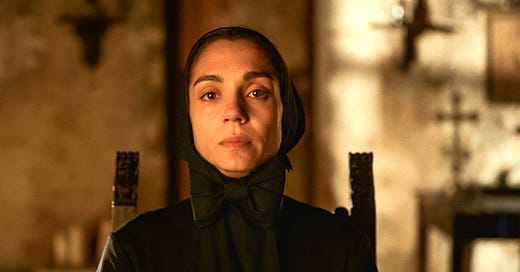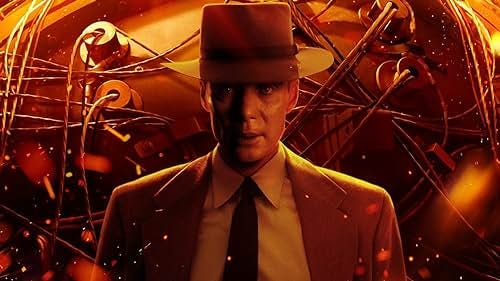“And my eyes see, Oppenheimer.” Talk about a strange, anti-climatic finale to the 96th Academy Awards. At least Oscar-winner Al Pacino presented the correct recipient, as opposed to the Warren Beatty-and-Faye Dunaway fiasco several years ago.
The show’s producers can’t seem to catch a break on the biggest award of the night…
Regardless, Christopher Nolan’s epic biopic about J. Robert Oppenheimer — the nuclear physicist who led the Manhattan Project that developed the atomic bomb — was crowned Best Picture, etching a spot in the pantheon of the greatest movies ever made.
After admiring his movies for nearly 20-plus years, I admittedly felt pride for Nolan finally receiving the Best Director award, as well as others in the film like Cillian Murphy (Best Actor) and Robert Downey Jr. (Best Supporting Actor). His films are some of my favorites.
Unfortunately, Oppenheimer is not at the top of my list. It had bursts of brilliant sequences carried by great performances, but the movie was nearly 20 minutes too long, had a soundtrack that drowned out critical dialogue, had borderline gratuitous sex scenes, and offered relatively little beyond what I anticipated in terms of Oppenheimer’s moral dilemma. This is not to say it is a bad movie — I found it simply good. But I’ll be revisiting Batman Begins, The Prestige, Inception, Dunkirk, and Memento before Oppenheimer.
The only other Best Picture nominee I had seen from 2023 was Barbie, which I found to be a weaker version of The Lego Movie, and a chaotic mess with moments of levity (mostly driven by Ryan Gosling’s performance).
But Oppenheimer’s victory is intriguing because, for the first time in 20 years, the Best Picture winner was a blockbuster. At nearly $1 billion in earnings, Oppenheimer is certainly one of the top-grossing Best Picture winners of all time along with Gone With the Wind, Titanic, Lord of the Rings: Return of the King, and Ben-Hur. Is it a sign of things to come? Will the Academy not only nominate but award movies people have actually seen? Time will tell, but, more likely than not, Oppenheimer will be an outlier. Past winners haven’t cracked $500 million globally in box-office grosses; several didn’t even eclipse $100 million. Below is a breakdown:
Oppenheimer: $953.8 million
Everything Everywhere All at Once: $111.4 million
CODA: $2.237 million
Nomadland: $38.7 million
Parasite: $253.2 million
Green Book: $319.9 million
The Shape of Water: $195.7 million
Moonlight: $64.8 million
Spotlight: $91.9 million
Birdman: $102.9 million
12 Years a Slave: $180.7 million
Argo: $227.1 million
The Artist: $128.1 million
The King’s Speech: $430 million
The Hurt Locker: $49.8 million
Slumdog Millionaire: $383.8 million
No Country for Old Men: $164 million
The Departed: $289.9 million
Crash: $101.1 million
Million Dollar Baby: $231.9 million
The Lord of the Rings: Return of the King: $1.121 billion
Chicago: $306.7 million
A Beautiful Mind: $317.6 million
Gladiator: $451.6 million
With 2024’s less-appealing slate, perhaps Dune Part II might follow Oppenheimer’s lead in the upcoming Best Picture race. Speaking of…
Dune Part II
Dune Part I had a less than climatic finale; but the sequel promised more of a conclusive ending. Sadly, I left the theater unsatisfied narratively. With the Lord of the Rings, I knew there would be an ending soon. Three books. Three movies. However, I am not so sure about Dune, considering the number of books in the series.
Still, Dune Part II was more enjoyable than its predecessor. The world is fascinating in certain respects (like the Harkonnens’ home, the interplanetary politics, and yes, the worms), and the scale is tremendous, especially during the exhilarating battles. Austin Butler was also a fantastic addition to the series — and might be the best performance in the movie. Timothée Chalamet is still unconvincing as a leader, but he exudes more pathos in Part II, which makes Paul Atreides a more well-rounded character.
Among the brilliant scenes, however, are questionable lapses in the editing bay, particularly of Paul crossing the desert to prove his worth, which feels severely cut. Plus, how does one get off the worms?!
Nitpicks aside, Dune Part II is very good, but not transcendent. However, I will see Part III. I just hope the story, theatrically, has an end and does not continue in perpetuity.
Kung Fu Panda 4
I haven’t seen the first Kung Fu Panda since its 2008 release. It was charming enough, but I never felt a desire to see the sequels. However, a friend asked me to see the fourth installment the other day — and I generally don’t say no to going to the movies. So, here we are.
There were times my brain felt on fire during Kung Fu Panda 4. The pacing is so rushed, rapidly moving from one plot point to the next without any meaningful contemplation of what transpired. However, this phenomenon is not unique to Kung Fu Panda 4, but to children’s media in general (at least of those I’ve seen). No wonder kids can’t sit still. For the first half of the movie, my senses were utterly bombarded. Thankfully, the pace finally settles enough toward the movie’s conclusion so the audience can feel the emotional weight of the characters’ decisions — as well as the plot holes.
Overall, it wasn’t terrible. There were a few clever gags. But it was more eye-opening about how kids are digesting content these days. Bottom line: it ain’t healthy.
*This review originally appeared in RealClear Religion.
Cabrini Film Falls Short on Faith
Mother Cabrini is anything but frail. Despite suffering from a long-term debilitating lung condition as a result of nearly drowning as a young girl, the Italian-American saint exhibits a tenacious resolve, tending to downtrodden immigrants in New York City, while clashing against the powerful in the Catholic Church and City Hall.
In short, the new film Cabrini produced by Angel Studios and directed by Alejandro Gómez Monteverde — the same team behind last year’s surprisingly successful yet controversial Sound of Freedom — offers movie audiences a “girl boss” worthy of imitation unlike in major blockbuster franchises such as Marvel, Star Wars and Indiana Jones.
The filmmakers recognized Mother Cabrini as a historical woman who displayed tremendous heroic virtue. To be sure, she became the first U.S. citizen canonized by the Catholic Church on July 7, 1946, for doing just that: humbly serving the poor and exhibiting the depths of God’s heart for humanity.
However, Cabrini’s saint played by Cristiana Dell’Anna — while honorable for her charity — lacks an examination of what rooted her virtuous life beyond an ambition to “conquer the world with hope,” as she describes. Ultimately, what or who is foundational to that hope is unresolved in a film that instead highlights worldly motivators to appeal to secular audiences.
One motivator is revealed while she is digging for well at Sacred Heart Orphan Asylum, a property abandoned by the Jesuits due a lack of drinking water (apart from a nearby river). Mother Cabrini suffers from insomnia; yet she is determined to succeed where others have failed. One night she shares to Vittoria (Romana Maggiora Vergano) — a prostitute whom she took in and cared for — that she fears resting because that’s when “death creeps in.” Diagnosed with only a few years to live, her plight is understandable. But fear of rest, while maybe realistic, was not the prime mover in her life. Some saints persevered through “dark nights of the soul,” as described by St. John of the Cross, but rest is necessary in the Christian life to hear God’s voice in the silence of our hearts. One of her religious sisters utters that “We will have time to rest in heaven,” but certainly it’s troubling when the film fails to depict the saint in prayer, which she hardly does. To not have prayer significantly depicted removes a core element of the real Mother Cabrini.
Secondly, Cabrini explores her pursuit of proving to powerful men that women are capable of leadership. Yet this element is more reminiscent of Back to the Future’s Marty McFly when he is called “chicken” by bullies. Even Pope Leo XIII (Giancarlo Giannini), who sends her order to America, cannot tell where Mother Cabrini’s faith ends and ambition begins. This motivation meets an unsatisfactory, even troubling, conclusion when Mother Cabrini finally faces the fictional anatagonist, Mayor Gould (John Lithgow), who represents the anti-Italian discrimination immigrants endured at the turn of the 20th century. Instead of revealing to the press about his administration’s part in setting fire to her hospital, Mother Cabrini — in a scene ripped out of Ghostbusters — offers her people’s support in an upcoming election if she is allowed to minister to their basic needs. Her heroic virtue is reduced to a seemingly contrived climax. Nevertheless, Mayor Gould is impressed by her political tact, finally accepting that perhaps Italians are not as backwatered or unintelligent as he presumed. He even tells her over a glass of Scotch, “You would’ve made a fine man.” Mother Cabrini responds that men cannot do what women can.
The film’s answer, however, should be Jesus Christ yet His name is mysteriously never uttered throughout the film. He is relegated to a tattered framed painting and a crucifix in hazy backgrounds. Of course, in film language, the latter symbolizes she is motivated by a love of God; but this is not enough for a woman who once said, “I will go anywhere and do anything in order to communicate the love of Jesus to those who do not know Him or have forgotten Him.” Even “God” is seldom mentioned apart from a plea to the Italian Senate to fund her New York City hospital or to City officials disinterested in immigrants’ living conditions in the notorious Five Points.
Surely, actions do speak louder than words, and Cabrini’s protagonist acts justly. In one heartfelt moment, Mother Cabrini is offered two choices of fabric for the children’s clothes. Without hesitation, she chooses the more expensive saying, “They will know,” emphasizing the dignity she sees in every human person — and how acts of self-sacrifice can transform other hearts. Ultimately, Mother Cabrini is proven right: the children and those who encounter her feel important, and reduced to outcasts living on society’s peripheries. The saint’s love for her fellow man is also depicted after she tends to victims of an industrial accident. In a moment of weakness, she weeps for the dead, knowing full well that if they were admitted to a more equipped hospital, fewer lives would have been lost.
Cabrini exorbitantly displays the saint’s charism and the corporal works of mercy, which is displayed throughout the movie. Faith is certainly not absent from the film, but it fails to prominently take center stage as one would hope on a deeper level.
It makes one question the film’s intended audience. Granted, Christian and/or faith-based movies tend to garner ridicule by secular audiences for poor production value and lacking subtlety. Cabrini, in those respects, is an outlier, far-and-away exceeding others in the genre with some truly beautiful cinematography. Nevertheless, faith-based movies also reap successful box office grosses when compared to their budgets. Essentially, Cabrini’s filmmakers did not have to fear producing a box-office dud — there is an audience craving for religious content. So why is Cabrini coy about her deep, inner relationship with God? It’s a commendable aspiration to want to lure religious ‘nones’ into the theater to examine a heroically virtuous person’s biography. But the film leaves an incomplete depiction of the saint’s heart, which may not convince secular viewers why they should learn more about the faith that inspired her to act.
To the movie’s credit, in the final moments, the filmmakers show how Mother Cabrini’s order did, in fact, spread across the world from East to West as she had envisioned. So one will admire her tireless work. Yet in the dramatic depiction, the final shot is of Mother Cabrini gazing at her adopted homeland from the mayor’s office, symbolizing her victory of “conquering” America. But it does not feel like she did so with “hope,” that hope being Jesus Christ.
In the end, Mother Cabrini is certainly more endearing and admirable than other “girl boss” heroines Hollywood has injected into pop culture. But without the hope and heroic virtue underpinning her entire life’s work and legacy, Cabrini falls short of convincing secular audiences what singularly differentiates her: She is not a “girl boss,” but much more — she is a saint.






